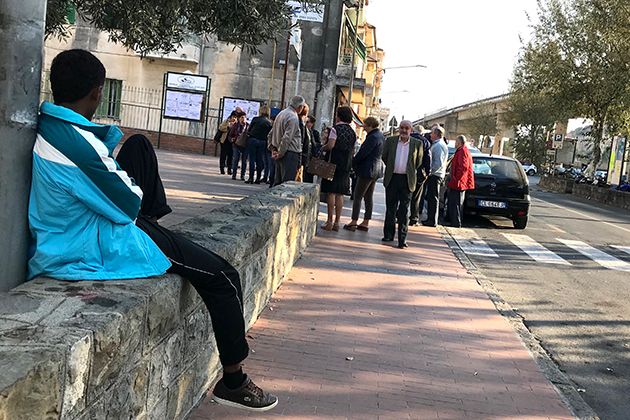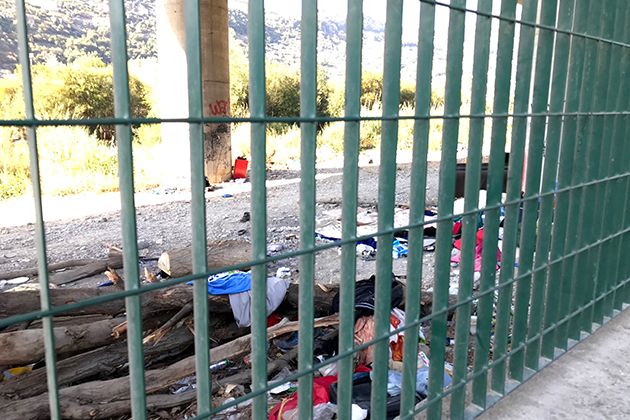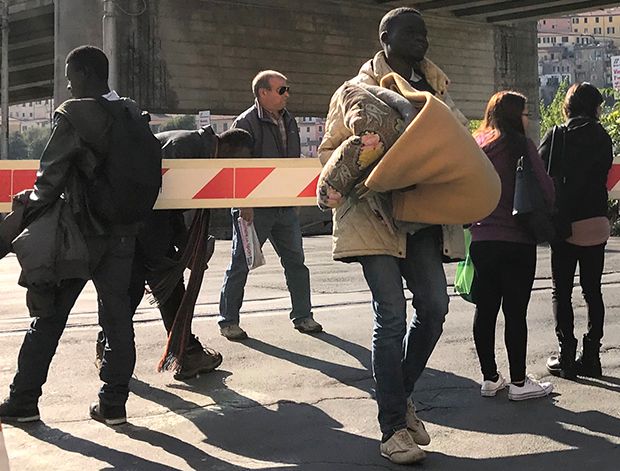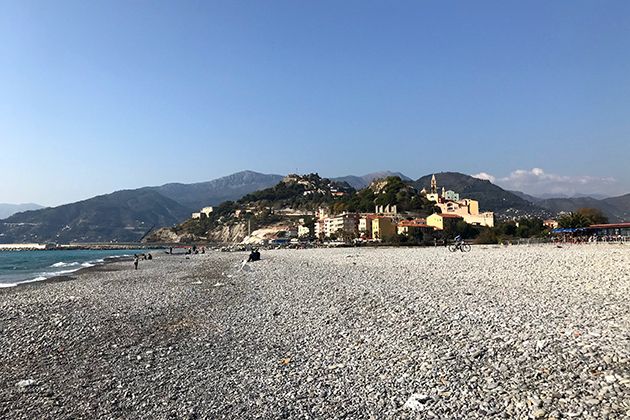
A young African migrant who lives in an informal camp on the banks of the Roya River watches as parishioners gather outside Sant’Antonio Catholic Church in Ventimiglia, Italy.
On a recent drive from Ventimiglia, Italy, to the French border, a four-mile trip along the Mediterranean coast, the sea glistened a turquoise blue, palm trees swayed and beachside villas were spotted among lush vegetation.
But the spectacular scenery was not what drew one’s gaze. Rather it fell on groups of young African migrants walking along the narrow road from the border in the direction of Ventimiglia, no sidewalks protecting them from cars zipping around tight curves.
“They have all been pushed back,” said Alessandro Verona, a medical doctor with Intersos, an Italian NGO that works with immigrants, who offered me a tour of the situation at the French-Italian border, where more than a dozen migrants have died in the past year.
Verona said the migrants along the road had tried to enter France from Italy by foot, were picked up by French police, who brought them to the border point outside the French town of Menton, where they were left to walk back to Italy.
Most were heading to a place of squalor that belies the beauty of this corner of Europe – an informal camp on the banks of the Roya River in Ventimiglia, the closest Italian town, where they sleep in the open without access to drinking water or toilets. They will regroup and try again and again, Verona said.

In early November, hundreds of refugees and migrants were living in this informal camp along the Roya River in Ventimiglia.
One teenager from the Darfur region of Sudan, interviewed in Ventimiglia in late October, said he had made 17 attempts to enter France, but was caught each time. Undeterred, he and a group of other Sudanese men were planning to embark that evening, after eating a bowl of lentil soup at a center near the river camp run by the Catholic charity Caritas.
“In Italy, I don’t speak the language. There is no work and in France, I have friends,” said Adam, 25, who was in the group. He speaks French and some English.
Hundreds of refugees and migrants -- mainly from sub-Saharan Africa but also from Tunisia, Algeria and Bangladesh -- are bottlenecked at the Italian-French border, blocked from reaching France and other countries to the north by European Union policy and France’s strict enforcement of it.
Their plight is a byproduct of steps taken to manage Europe’s recent influx of refugees and migrants, which peaked in 2015. Officials estimate 600,000 have entered Italy in the past four years.
Under EU policy, refugees and migrants must apply for asylum or legal status in the first country they enter. Those in Ventimiglia used the dangerous central Mediterranean crossing from Libya to southern Italy.
A similar situation exists in the northern French port of Calais, where in October 2016 the government there razed the so-called “Jungle” camp, where thousands of refugees had gathered before trying to cross the Channel into Britain. Six hundred to 700 migrants are now in Calais, officials estimate.
The migrants in Ventimiglia are obliged to remain in Italy until their legal status is decided, a process lasting a year or longer. That is why France can push them back.
But their desire to reunite with family or friends and reach more prosperous economies draws them to the border. “None want to stay in Italy,” said Verona.

Along Via Tenda in Ventimiglia, a young African man carries bedding down to the riverbank, where he will join an informal camp.
Serena Regazzoni, a Caritas employee, said the Ventimiglia center serves 230-250 meals a day, indicating how many migrants live by the river. Aid workers say another 400 or so, including families and women, are housed in a Red Cross camp a few miles out of town where they get meals and live in shipping containers.
Fiesz, the teenager who made 17 border crossings, and his friends choose to live rough by the river because they’ve heard the Red Cross center doesn’t let residents leave overnight, when they prefer to head to France.
Most migrants end up taking paths over a mountain pass, sometimes guided by traffickers who charge about $100 a person, or they go on their own. Verona said decades ago one path had served as an escape route for Jews fleeing racial laws in Fascist Italy.
While French authorities also patrol the rural areas where the mountain paths lead, many migrants eventually make it through after repeated tries. “This is why we will always have people passing through here,” Verona said.
Attempting the crossing can be deadly. According to Open Migration, a non-profit research organization, 15 migrants were killed in the Ventimiglia area between September 2016 and last August.
“Drowned, run over, fallen, and electrocuted, migrants keep dying in their attempts to cross the border or get lost and hurt themselves in dangerous places,” stated an Open Migration report published last July.
Verona said a 17-year-old Sudanese boy drowned in June after he apparently slipped into the river while trying to retrieve a shoe he was washing. A 17-year-old Eritrean girl was struck and killed by a car in the tunnel.
“I don’t think the concept of humanity is represented in all of this,” said Verona.

Ventimiglia is the closest Italian town to the French Border. It is situated where the Roya River meets the sea.
The Rev. Rito Alvarez, whose Sant’Antonio Catholic church faces the river encampment, questioned why the situation in Ventimiglia continues.
“This is the heart of Europe,” the priest said in an interview. “What is moral or ethical about what is happening at the river where people are sleeping under the bridge with no water, no food?”
Until two months ago, the church had housed migrant women and families. The local government closed the shelter under pressure from residents, and those living at the church moved to the Red Cross camp.
On a recent afternoon, three young Eritreans approached Alvarez outside the church and asked for rosaries, which were quickly fetched and distributed.
Alvarez finds irony in the fact a cemetery in Menton, just over the border, includes graves of African soldiers recruited by France from its colonies to fight in World War I.
“If you go there and read the names, they are the same names as these young men outside. They could be their great- great-grandfathers,” he said. “There is a lack of historic memory.”
